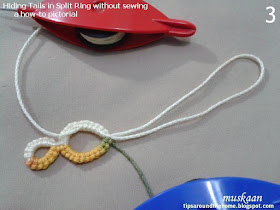Floating Beads –
how to pictorials
Part 1
muskaan © August 2017
There are ways to dangle a bead in tatting such as
Corina’s fringe, threading the bead when needed, using a long picot, to name a few.
But what if one needs to dangle a bead inside a ring – a thrown/floating ring
at that? What if the bead(s) that need dangling are large and would hamper
tatting if pre-strung on a shuttle?
I came across tutorials and images of a bead in the center
of a ring/mock ring, anchored at both ends. I was looking to freely suspend a
bead in a thrown ring without distorting any tatting or unwinding any shuttle. After
many unsuccessful or unsatisfactory attempts, I figured out this Floating Beads
method and my first trials gradually led to many more applications of the
method. This method both suspends and secures the bead(s) in an element.
After consultation with Stephanie & Georgia we settled on the term Floating Beads since the bead is not anchored at the other end, and does dangle or float.
Perhaps it can be abbreviated/notated to FB ? What do you think ?
After consultation with Stephanie & Georgia we settled on the term Floating Beads since the bead is not anchored at the other end, and does dangle or float.
Perhaps it can be abbreviated/notated to FB ? What do you think ?
I will be sharing the various elemental applications over 3 or 4 posts including 1 alternate method (on Nina Libin’s suggestion) and the earring pattern.
Eventually these will be converted into pdf - I can’t decide whether to have them in one single pdf or multiple pdfs, and in which sequence. I hope you can suggest something going forward.
Eventually these will be converted into pdf - I can’t decide whether to have them in one single pdf or multiple pdfs, and in which sequence. I hope you can suggest something going forward.
Introductory posts showing various applications: Bead(s) in rings ; Bead(s) under a chain
I. Floating Bead in Thrown/Floating
Ring
Step 1 can be altered to suit bead size and numbers (this
will be shared later).
Step 2 can be repeated if one wants the bead at a slight
distance from the top.
Materials used :
Shuttle 1 red; shuttle 2 blue; Anchor
size 20 threads; 4.5mm Swarovski crystal bead ; hook to load bead
1. Make
a chain.
2. Before
starting the thrown ring, pull shuttle 2 thread through bead.
3. Fold
the loop back around the base of the bead;
4. Bring bead closer to base, rotate bead slightly so that the openings are horizontal.(see
pic5)
Keep the anchored part of loop
under left hand finger while pulling on shuttle thread to tension the
loop around bead. This takes a bit of practice initially.
Important Notes :
- For
the bead to dangle properly & avoid distortion, it is important that there is a tiny space on
the shank, and the bead is just sufficiently snug.
- In
case of small bead, instead of looping back, pass shuttle 2 through the
loop, position with rotation, and tension. Continue with next step.
5. Fully
enclosed but position can be unstable. Hence one more step to secure …
6. Bring
shuttle 2 thread around the bead …
7. and
pass shuttle through the loop.
8. Tension
it, making a half hitch or overhand knot at the base encapsulating the bead.
Note : By repeating this step (on a longer shank) the bead will dangle lower.
9. Start
thrown ring with shuttle 2 normally and tat around bead.
10. Close
ring
11. Switch
shuttles and continue chain.
12. Floating
bead in a thrown/floating ring ! No distortions !
My sincere thanks to all my tatting friends - Georgia, Stephanie, Eliz, Nina, & Usha - for their active interest and participation in this journey; and to all my readers who also showed an interest, leaving comments and sending emails.
to be continued ...



















































